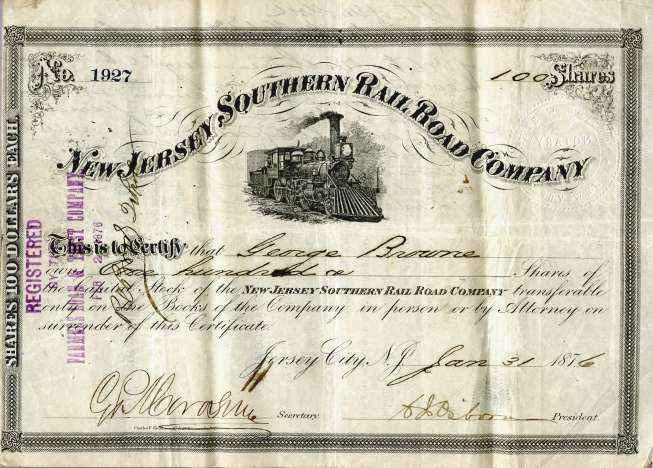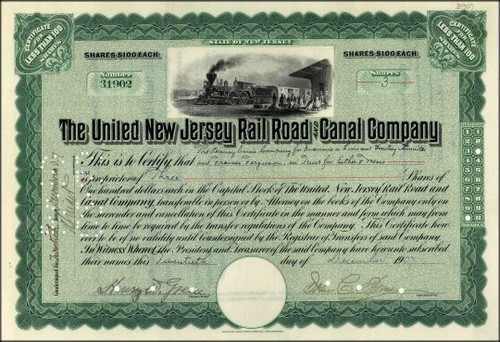Beautiful Scarce stock certificate from the New Jersey Southern Rail Road Company issued in 1876. This historic document was has an ornate border around it with a vignette of a train. This item has the signatures of the Company's President, C. J. Osborn and Secretary. 
Certificate AMERICA'S SUCCESSFUL MEN CHARLES J. OSBORN, stock broker, originated in Quogue, L. I., and died in New York City, in 1885, less than fifty years of age. His first experience was in the leather trade as clerk and later as partner of Israel Corse in the " Swamp." He entered Wall street about 1865, and, as member of the Gold Board, made his fortune in the great speculations of that time. In 1869, he formed a partnership with Addison Cammack, as Osborn & Cammack, and operated on an enormous scale in gold for Jay Gould. The firm were Mr. Gould's most trusted brokers, their transactions amounting to hundreds of millions. This partnership terminated in 1872. Mr. Osborn then formed the firm of C. J. Osborn & Co., of which John W. George and Edwin S. Chapin were general and Jay Gould special partners. They passed through the panic of 1873 successfully. In 1883 Mr. Osborn retired, and was at the time of his death a special partner in the firm of E. S. Chapin & Co. Thereafter, he devoted some time to the settlement of the affairs of the broken Wall Street Bank, as receiver, saving enough from the wreck to pay the depositors in full and giving his services without recompense. He was a member of the Stock Exchange 1869-83, serving on the governing committee at one time, and was also a member of the New York, American Yacht and Coney Island Jockey clubs. He owned the famous yacht Dreadnaught and the steam yacht Corsair. He married Miss Miriam A. Trowbridge, who with his son, Howell Osborn, survived him. The latter died Feb. 5, 1895. The New Jersey Southern Railroad (NJS) began life as the Raritan and Delaware Bay Railroad Company (R&DB), in March 1854. The R&DB was chartered to construct a railroad from the Raritan Bay to Cape Island (Cape May), near the outlet of the Delaware Bay. It was to form part of a rail and water route from New York to Norfolk, Virginia. The man behind it was William A Torrey, who owned 43 square miles (110 km2) in the area of present-day Lakehurst. Construction began in 1858 from Port Monmouth on Raritan Bay. The first segment opened in June 1860 ran south via Red Bank as far as Eatontown and then by a branch running east to the resort town of Long Branch on the shore. It was the first railroad to reach Long Branch. Summer service in the first year was three train and boat trips per day in each direction. This first section included what would remain the two largest engineering works on the line: the long pier at Port Monmouth and the Navesink River bridge at Red Bank. Later in 1860 the main line was opened as far as Lakewood. As construction continued, instead of turning southeast at Lakehurst to Toms River and parallel to the shore to Cape May, the main line continued southwest, opening to Whiting (Manchester Township) and Atsion (now in Wharton State Forest) in 1862. The route passed through the center of the lightly populated Pine Barrens, and was connected to towns on Barnegat Bay only by stages running on public roads. A branch to Toms River was opened later, in 1866, and extended to Waretown in 1872. The reason for the Pine Barrens routing soon became clear. In September 1862, the R&DB and the Camden and Atlantic Railroad began operating a through service between New York and Philadelphia once a day, without change of trains between Port Monmouth and Camden. To make this possible the two railroads had built a connecting line from Atsion to Atco on the Camden and Atlantic Railroad.[6] As roundabout as it was, this service caused controversy because it broke the state-authorized monopoly of the Camden and Amboy Railroad for travel between New York and Philadelphia. But as the Civil War put demands on the railroads to transport troops and materials, the Camden and Amboy Railroad proved notoriously unable to handle the traffic on its one-track main line across New Jersey, and the R&DB rapidly became a valuable alternate route. 17,500 troops were sent via the R&DB over nine months starting September 1862. But the Camden and Amboy Railroad took the matter to court, and tried to use its influence in the state legislature to dissolve the R&DB, while the R&DB appealed to the United States Congress to protect its operation. Through service to Camden was discontinued in February 1866, and in December 1867 the R&DB lost its case on appeal and was ordered to close the section of line from Atsion to Atco, making it impossible for passengers to travel to Camden even by changing trains.[9] The Camden and Amboy's zealous defense of its rights is all the more remarkable because the monopoly was set to expire on January 1, 1869. The Camden and Amboy Railroad further weakened the R&DB by supporting a competing service to Long Branch. The Long Branch and Sea Shore Railroad was opened in 1865 from Spermaceti Cove on Sandy Hook down the narrow sand spit to a station in Long Branch near the R&DB station. This route was shorter and faster both by sea and land than the R&DB route, which had been built incidental to the main line to southern New Jersey. The Camden and Amboy Railroad supplied the locomotives and cars for the new road. The LB&SS would later become part of the New Jersey Southern. The R&DB company, having exhausted its limited resources on the fight with the Camden and Amboy Railroad, went into bankruptcy, and was reorganized under new management as the New Jersey Southern Railroad near the end of 1869. That summer, a cooperative arrangement with the Camden and Amboy Railroad permitted operation of a train service from Philadelphia to Long Branch, via Trenton, Monmouth Junction, and Farmingdale, using the R&DB main line and branch north of Farmingdale. New Jersey Southern Railroad The new company was created by railroad financier Jay Gould. He had first taken over the Long Branch and Sea Shore Railroad, when it was of no further interest to the Camden and Amboy, and improved it by extending it farther north on Sandy Hook to Horse Shoe Cove. From this base he then acquired the former R&DB. The Horse Shoe Cove dock was more sheltered than Port Monmouth, and its better access to Long Branch made it the preferred route for the combined railroads. Boat service to Port Monmouth was discontinued about 1871. Trains now ran through from Sandy Hook to Long Branch to Eatontown Junction and from there down the NJS main line to southern New Jersey. Some service continued to run on the old NJS route from Port Monmouth via Red Bank to Eatontown. Meanwhile down in south Jersey, the main line was finally extended to Delaware Bay, but not by the NJS. The Vineland Railway started at the end of the NJS at Atsion, crossed the Camden and Atlantic at Winslow Junction, and reached the agricultural town of Vineland in 1870. This company was backed by Charles K. Landis, the founder of Vineland as a somewhat utopian community. The railway was continued onward to Delaware Bay at Bay Side in 1871. The New Jersey Southern's plan now was to reach Baltimore by means of the Vineland Railway, a boat across Delaware Bay, a railroad across the Delmarva Peninsula, and a boat across Chesapeake Bay, according to a statement issued in 1873 over the signature of Jay Gould, President. The only lengthy NJS branch in south Jersey ran from Bridgeton to a place called Bivalve, on the Maurice River in Port Norris. It was opened in 1872 by the Bridgeton and Port Norris Railroad, but connected at Bridgeton not with the NJS but with the West Jersey Railroad running to Camden. The principal commodity was oysters, at that time plentiful in the area and much in demand. The NJS did not acquire this line until 1887, after the B&PN company had failed and it was reorganized as the Cumberland and Maurice River Railroad. Also at this time two connecting lines were built in central Jersey, both from Whitings. The Pemberton and New York Railroad ran west to meet a railroad from Camden near Pemberton. The other, the Tuckerton Railroad, ran southeast to reach the bay towns from Waretown (which was also on the NJS's branch from Lakehurst) to Tuckerton. Gould lost control of the New Jersey Southern Railroad company in the Panic of 1873 and it went into receivership. The New Jersey Southern was formally acquired by the Central Railroad of New Jersey in September 1879. The Central Railroad of New Jersey was among the railroads merged into ConRail in April 1976. History from Wikipedia and OldCompany.com (old stock certificate research service)

Certificate








